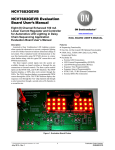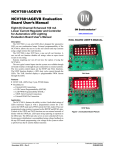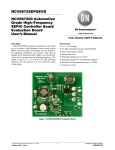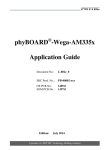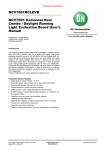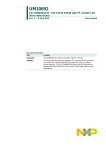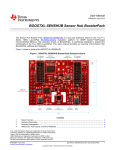Download NCV7691GEVB - ON Semiconductor
Transcript
NCV7691GEVB NCV7691 Current Controller with Automotive LED Lamps in Sequencing Application Evaluation Board User'sManual http://onsemi.com EVAL BOARD USER’S MANUAL Description Automotive turn signals are sometimes designed to display an indicator in a fashion such that lights are activated in a sequencing manner to show directional intent. This evaluation note highlights the use of standard logic integrated circuits with the NCV7691 devices to provide a solution for a sequencing design. The system consists of the LED current controllers (NCV7691 x 3), a voltage regulator (NCV8664), a timer IC (NCV1455B), a shift register (MC74HC164A), and a NAND gate (MC74HC20A). The evaluation board has an on−board LED array to highlight a sequencing solution for automotive indicators. An additional 10−pin edge connector allows for connection to external LEDs (often at higher current by modifying the current programming resistors). Features In addition to the NCV7691 part features, this evaluation board highlights the following: • Sequencing Functionality • Open Circuit Reporting ♦ Indicator On−board ♦ Connection for Off−board Communication • External LED Load Connectivity • Bright / Dim Switch for Easy Viewing • 5 V Regulator Output Figure 1. Board Top © Semiconductor Components Industries, LLC, 2014 June, 2014 − Rev. 5 Figure 2. Board Bottom 1 Publication Order Number: EVBUM2211/D NCV7691GEVB Basic Demonstration Open Circuit Detection Figure 3 provides a representation of the display feature of this evaluation board. 1. When the board is powered, 3 sets of LED strings are initialized in the off state. 2. The 1st string of LEDs turns on. 3. After a delay period, the 2nd string of LEDs turns on while the 1st string remains illuminated. 4. After a similar delay period, the 3rd string of LEDs turns on while the 1st and 2nd string remain illuminated. 5. All 3 strings remain illuminated for an extended period of time. 6. The progression is repeated as all 3 sets of LED strings transition to the off state. The NCV7691 utilizes the voltage feedback network to the FB pin for detection of open circuit conditions to be reported at the FLTS pin. An open circuit condition using this board can be simulated by removing Jumpers J1, J2, and J3. The open circuit is indicated at the on−board LED bar, but J5 may be removed to route the signal off the board if desired. Detection of open circuit conditions require jumpers J8, J9, and J10 to be connected when using the on−board LED array LED loads. The low current setup with the LED array using supplied board resistor values for R3, R7, and R8 of 8.2 W will illuminate each segment of the LED array at 18 mA. The drive capability of the NCV7691 to the base of the external transistor has a value per the datasheet between 14 mA and 30 mA. An open circuit condition might fail to be detected if all of the drive current is directed to the base of the BCP56 device to the emitter of the BCP56 device through to the sense resistors on the FB pins (R3, R7, R8). e.g. If the drive capability of the NCV7691 is 18 mA, and 18 mA is provided to the base, the voltage at the FB pin will be at the regulation voltage (150 mV) with or without an open circuit event. The voltage generated on the FB pin will be high enough for the system to think the device is regulating and no open circuit exists. This is why three jumpers are provided on the demo board (J8, J9, J10). Connecting these jumpers provides a load directly to the base drive node to eliminate some of the base drive so that an open circuit condition will be detected. Figure 3. NCV7691 Sequencing http://onsemi.com 2 NCV7691GEVB Figure 4. Evaluation Board Schematic EVALUATION BOARD SCHEMATIC http://onsemi.com 3 NCV7691GEVB THEORY OF OPERATION The sequencing system design is comprised of all the blocks shown in the diagram below. The Linear regulator provides a 5 V regulated line to the logic ICs (Timer, Shift Register, and NAND gate). The timer provides the clock for the shift register, and the NAND gate provides the required state to the NCV7691 pre−driver devices. LOAD3 LOAD2 LOAD1 VPWR R6, 680 W R12, 680 W R7, 680 W Q1 BCP56 Q3 BCP56 Q2 BCP56 R3 R2 R8 To microprocessor R4 VPWR R10 R5 SC VS PWM BASE M1 2N7002W FB C1 0.1 mF FLTS NTC GND NCV7691 VPWR VS SC PWM BASE FB FLTS NTC VPWR GND SC VS NCV7691 PWM BASE FB FLTS NTC GND NCV7691 Linear Regulator (NCV8664) Timer (NCV1455B) Shift Register (MC74HC164A) NAND Logic (MC74HC20A) Figure 5. http://onsemi.com 4 NCV7691GEVB LOGIC through values 100, 110, 111, and 000. The following figure displays the timing of these outputs relative to the clock input. The NCV1455B timer output is connected to the clock input of the MC74HC164A shift register. At every rising edge of clock, the shift register outputs QA, QB, and QC change. In four clock pulses, the output QAQBQC cycles Figure 6. Shift Register Clock Input and Parallel Data Outputs This is also highlighted in the scope capture of Figure 7. Figure 7. Shift Register (MC74HC164A) Outputs, Pin 3 (yellow), Pin 4 (pink), Pin 5 (blue) The evaluation board includes three NCV7691 current controller ICs that drive one LED string each. Shift register outputs QA, QB, and QC are connected directly to the NCV7691 PWM inputs. When the PWM signal goes high, the driver output goes high and the LEDs turns on. Therefore, when the shift register outputs a signal of 100, LED1 is on. A shift register output of 110 corresponds to LED1 and LED2 turning on, and a signal of 111 will turn all three LEDs on. When QA, QB, and QC are all 0, all three LEDs are off. The MC74HC20A (NAND) device provides the logic necessary to extend the timer when the 111 condition is present in the shift register. The MC74HC20A interfaces to the BSS84L PFET during this condition adding extra capacitance (C7) in the timer circuit (NCV1455B). Automotive turn signal applications frequently use this to indicate a direction, and then hold the signal present for a duration of time longer than the shifted signal. http://onsemi.com 5 NCV7691GEVB ABSOLUTE MAXIMUM RATINGS The operation of the NCV7691 sequencer evaluation board works as a standalone presentation for the customer highlighting the sequencing function often used in automotive turn signals. The on−board LED array is used for situations where simplicity is needed. An additional edge−connector can be used for alternative LEDs. Jumpers J1, J2, and J3 provide the interface switch for the edge−connector. Higher currents are assumed to be used with the edge−connector, so extra care must be taken not to reposition the jumpers for high currents through the on−board LED array. Table 1. ABSOLUTE MAXIMUM RATINGS Rating Value Unit −0.3 V (min), 45 (max) V LED Current Source (TP2, TP4, TP5) (Edge Connector)(BCP56) 1 A LED Current Source max voltage (TP2, TP4, TP5) (Edge Connector)(BCP56) 80 V Supply Voltage to board (TP1, VBB) (NCV8664) Open Circuit Voltage (TP6, Open Circuit) (2N7002W) 60 V Open Circuit Sink Current (TP6, Open Circuit) (2N7002W) 220 mA Junction Temperature (NCV7691) −40 to 150 °C Ambient Temperature (Evaluation Board) −40 to 105 °C Stresses exceeding Maximum Ratings may damage the device. Maximum Ratings are stress ratings only. Functional operation above the Recommended Operating Conditions is not implied. Extended exposure to stresses above the Recommended Operating Conditions may affect device reliability. Table 2. RECOMMENDED BOARD OPERATING CONDITIONS Value Min Max Unit External Digital Supply Voltage (VBB) 7 16 V LED Current Source(TP2, TP4, TP5)(Edge Connector) (Note 1) − 1 A −40 150 °C Rating Junction Temperature (NCV7691) 1. Beta of the BCP56 external driver at the specified operating temperature must be considered when operating at high currents in order to obtain the system design goals. Table 3. PIN FUNCTION DESCRIPTION Connector Pin Number Terminal Name Power TP1 Edge Connector Pins 1 & 2 VBB Power supply input voltage (14 V). GND GND Ground. TP2 Edge Connector Pins 3 & 4 LED1 Connection to BCP56 collector current source output for U1 (NCV7691). TP4 Edge Connector Pins 5 & 6 LED2 Connection to BCP56 collector current source output for U2 (NCV7691). TP5 Edge Connector Pins 7 & 8 LED3 Connection to BCP56 collector current source output for U3 (NCV7691). TP6 Open Circuit Or’d connection from the 3 NCV7691 open circuit detection. TP7 Vout (5 V) Connection Points Test Points Description Connection to the NCV8664 5 V regulator output. http://onsemi.com 6 NCV7691GEVB Power supply connections. Open Circuit jumper and post. External LED edge connector. Vout (5 V) External LED post connections. On−board / Off−board Jumpers. External LED current programming resistors. Bright / Dim Control Base Load Resistor Jumpers Figure 8. Evaluation Board Highlights OPERATIONAL GUIDELINES Using the Evaluation Board with external LEDs The material necessary to successfully use the evaluation boards is listed below: • NCV7691 Evaluation Board • 14 V Power Supply Capable of driving 1 A. 1. Calculate the programming resistor value you need by referring to the NCV7691/D datasheet. a.) At nominal operating voltages the equation for programming current is 0.15 V/Rx where Rx is the equivalent resistance from the NCV7691 FB pin to ground. b.) On the board, using switch SW1 disengaged (DIM), the resistors are R3 (for LED1), R7 (for LED2), and R8 (for LED3). When the switch is engaged (BRIGHT) a resistor is put in parallel with the DIM resistor value. These are R14 (for LED1), R15 (for LED2), and R16 (for LED3). Connect a 14 V power supply to the power supply connections. The board should start working immediately. Evaluation Board Options 1. Open Circuit Jumper and Post. Allows disconnection from the drain of the open circuit indicator from the LED array to an external connection. 2. External LED edge connector. Connection for use with external LEDs. Note, the On−board / Off−board jumpers should be moved to the right for off−board connection. Reference the NCV7691/D datasheet for details on choosing a resistor value. 3. Bright / Dim Control. Controls a parallel connection for a programming current resistor for viewing ease. 4. External LED current programming resistors – Current setting resistors for high current switched in with the Bright / Dim dipswitch. 5. On−board / Off−board Jumpers. For setting the board for use with the LED array or an external LED via the edge connector. 6. External LED post connection. Optional connection for external LEDs as an alternative to the edge connector. 7. Vout (5 V). Connection to the 5 V regulator used to power the on−board logic. 2. Once the resistors are mounted on the board, move the jumpers from on−board to off−board (J1, J2, and J3). 3. Connect your external LEDs cathode either through the edge connector or the posts (TP2 [LED1], TP4 [LED2], and TP5[LED3]). The LED anode (string) should be tied to a high voltage (VBB suggested). 4. Connect a 14 V power supply to the power supply connections. The board should start working immediately. http://onsemi.com 7 NCV7691GEVB Table 4. JUMPER DESCRIPTION Jumper # Description J1−J3 Directs current to on−board LED array or external LED board via the edge connector. Removing jumpers simulates an open circuit condition. J5 Removes open load indicator from LED array to transistor source output (Q1) when jumper is removed. J8−J10 Adds loads (R10, R11, R12) to the bases of the BCP56 transistors when the jumper is added for use with light loads to allow for open load detection. Figure 9. NCV7691 Sequencing BILL OF MATERIALS Table 5. NCV7691 SEQUENCING EVALUATION BOARD BILL OF MATERIALS Description Value Tolerance Footprint Manufacturer Manufacturer Part Number Substitution Allowed Designator QTY U1, U2, U3 3 NCV7691 Current Controller −−− −−− SOIC−8 ON Semiconductor NCV7691D1R2G No U4 1 8−Bit Serial−Input/Parallel−Output Shift Register −−− −−− SOIC−14 ON Semiconductor MC74HC164ADR2G Yes U8 1 Timer −−− −−− SOIC−8 ON Semiconductor NCV1455BDR2G Yes U9 1 Dual 4−Input NAND Gate −−− −−− SOIC−14 ON Semiconductor MC74HC20ADR2G Yes U10 1 Very Low Iq Low Dropout Linear Regulator −−− −−− DPAK ON Semiconductor NCV8664DT50RKG Yes Q1 1 Small Signal MOSFET −−− −−− SC−70 / SOT−323 ON Semiconductor 2N7002WT1G Yes Q2, Q3, Q4 3 NPN Silicon Epitaxial Transistor −−− −−− SOT−223 ON Semiconductor BCP56−10T1G No Q5 1 Single P. Channel Power MOSFET −−− −−− SOT−23− 3 ON Semiconductor BVSS84LT1G Yes R1, R2 2 10K Timer Resistor 10K 1% 0805 Vishay/Dale CRCW080510K0FKEA Yes R4, R5, R6 3 10K Short Circuit Interface Resistor 10K 1% 0805 Vishay/Dale CRCW080510K0FKEA Yes R13 1 1K Open−circuit LED drive resistor 1K 1% 0805 Vishay/Dale CRCW08051K00FKEA Yes R3, R7, R8 3 8.2 W LED array programming resistors 8.2 1% 0805 Vishay/Dale CRCW08058R20FKEA Yes R9 1 1 W Shift register pull−up 1 1% 0805 Vishay/Dale CRCW08051R00FKEA Yes R14, R15, R16 3 High Current programming resistor Customer Defined 1% 1206 Vishay/Dale Customer Defined Yes R17 1 620 W 5 V LED drive resistor 620 1% 0805 Vishay/Dale CRCW0805620RFKEA Yes C1 1 Regulator Output Capacitor 10 mF, 10 V 10% 1206 Murata Electronics North America GRM31CR61A106KA01L Yes C2 1 Timer Capacitor 10 mF, 10 V 10% 1206 Murata Electronics North America GRM31CR61A106KA01L Yes C3 1 Supply Line Filter Capacitor 0.1 mF, 50 V 10% 0805 Murata Electronics North America GRM21BR71H104KA01L Yes C4 1 Timer Control Voltage Capacitor 0.01 mF, 50 V 10% 0805 Murata Electronics North America GRM216R71H103KA01D Yes http://onsemi.com 8 NCV7691GEVB Table 5. NCV7691 SEQUENCING EVALUATION BOARD BILL OF MATERIALS Designator QTY Description Value Tolerance Manufacturer Part Number Substitution Allowed Footprint Manufacturer C5 1 Fault Timer Capacitor 0.1 mF, 50 V 10% 0805 Murata Electronics North America GRM21BR71H104KA01L Yes C6 1 Power Supply Input Filter Capacitor 0.1 mF, 50 V 10% 0805 Murata Electronics North America GRM21BR71H104KA01L Yes C7 1 Extended Timer Capacitor 33 mF 20% 1206 TDK Corporation C3216X5R1A336M160AB Yes D1 1 5 V LED Indicator −−− −−− 0805 Lite−On Inc LTST−C171GKT Yes J1, J2, J3 3 On−Board / Off−Board Jumper −−− −−− JP3 Molex Connector Corporation 22−28−4033 Yes J4 1 LED Array Socket −−− −−− DIP20 3M 4820−3000−CP Yes −−− 1 LED Array −−− −−− DIP20 Avago HDSP−4840 Yes J5 1 Open Circuit Jumper −−− −−− JMP Molex Connector Corporation 22−28−4023 Yes J6 1 10−pin Edge Connector −−− −−− EDGECO NN10 Sullins Connector Solutions EBC05DRAS Yes J7 1 Supply Input Terminal −−− −−− MKDSN2 Phoenix Contact 1729128 Yes SW1 1 Bright / Dim Switch −−− −−− DIP6 Grayhill Inc 78G01ST Yes TP1−TP8 8 Test Point −−− −−− TP Keystone Electronics 5010 Yes ON Semiconductor and are registered trademarks of Semiconductor Components Industries, LLC (SCILLC). SCILLC owns the rights to a number of patents, trademarks, copyrights, trade secrets, and other intellectual property. A listing of SCILLC’s product/patent coverage may be accessed at www.onsemi.com/site/pdf/Patent−Marking.pdf. SCILLC reserves the right to make changes without further notice to any products herein. SCILLC makes no warranty, representation or guarantee regarding the suitability of its products for any particular purpose, nor does SCILLC assume any liability arising out of the application or use of any product or circuit, and specifically disclaims any and all liability, including without limitation special, consequential or incidental damages. “Typical” parameters which may be provided in SCILLC data sheets and/or specifications can and do vary in different applications and actual performance may vary over time. All operating parameters, including “Typicals” must be validated for each customer application by customer’s technical experts. SCILLC does not convey any license under its patent rights nor the rights of others. SCILLC products are not designed, intended, or authorized for use as components in systems intended for surgical implant into the body, or other applications intended to support or sustain life, or for any other application in which the failure of the SCILLC product could create a situation where personal injury or death may occur. Should Buyer purchase or use SCILLC products for any such unintended or unauthorized application, Buyer shall indemnify and hold SCILLC and its officers, employees, subsidiaries, affiliates, and distributors harmless against all claims, costs, damages, and expenses, and reasonable attorney fees arising out of, directly or indirectly, any claim of personal injury or death associated with such unintended or unauthorized use, even if such claim alleges that SCILLC was negligent regarding the design or manufacture of the part. SCILLC is an Equal Opportunity/Affirmative Action Employer. This literature is subject to all applicable copyright laws and is not for resale in any manner. PUBLICATION ORDERING INFORMATION LITERATURE FULFILLMENT: Literature Distribution Center for ON Semiconductor P.O. Box 5163, Denver, Colorado 80217 USA Phone: 303−675−2175 or 800−344−3860 Toll Free USA/Canada Fax: 303−675−2176 or 800−344−3867 Toll Free USA/Canada Email: [email protected] N. American Technical Support: 800−282−9855 Toll Free USA/Canada Europe, Middle East and Africa Technical Support: Phone: 421 33 790 2910 Japan Customer Focus Center Phone: 81−3−5817−1050 http://onsemi.com 9 ON Semiconductor Website: www.onsemi.com Order Literature: http://www.onsemi.com/orderlit For additional information, please contact your local Sales Representative EVBUM2211/D













